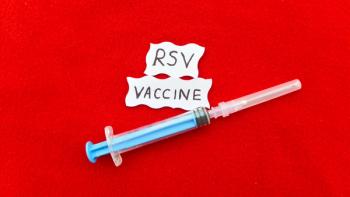
- November 2018 Cough, Cold, & Flu
- Volume 84
- Issue 11
Acute Bronchitis and Rhinosinusitis: Perspectives From Antimicrobial Stewardship
The overuse of antimicrobials is associated with antimicrobial resistance, which is now a global crisis.
The overuse of antimicrobials is associated with antimicrobial resistance, which is now a global crisis. More than 700,000 deaths result from antimicrobial resistance each year. If this problem is left unchecked, the number of deaths will increase to an estimated 10 million per year by 2050, or 1 death every 3 seconds.1
Antimicrobial stewardship involves optimizing antimicrobial use to balance the patient’s immediate need for treatment with society’s need for effective antimicrobials in the future.2 The outpatient setting is ideal for antimicrobial stewardship practices, as up to 80% of antimicrobial use occurs in this setting.3 Furthermore, 30% to 60% of these prescriptions are considered suboptimal, and 30% are considered unnecessary altogether.4,5
Much of the inappropriate use of antimicrobials in the outpatient setting is for respiratory infections, including acute bronchitis and rhinosinusitis.4 Below is a review of the treatment of acute bronchitis and rhinosinusitis in healthy adult patients who do not have chronic lung disease or who are immunocompromised.
Acute bronchitis is a self-limited lower respiratory tract infection affecting the large airways of the lung and produces a cough that typically lasts less than 3 weeks.6-8 It affects about 5% of adults annually and is more common in the fall and winter.6 It is caused primarily by respiratory viruses, including adenovirus, coronavirus, enterovirus, human metapneumovirus, influenza A and B parainfluenza, respiratory syncytial virus, and rhinovirus.7 Less than 10% of cases are bacterial in origin, with atypical bacteria such as Bordetella pertussis, Chlamydophila pneumoniae, and Mycoplasma pneumoniae as the culprits.9-11
The early course of acute bronchitis mimics that of the common
The treatment of acute bronchitis involves primarily supportive care.10 Patients may benefit from symptomatic relief, with antihistamines, β-agonists, cough suppressants, decongestants, and expectorants.6-8 Nonpharmacologic measures, such as avoiding cigarette smoke, drinking hot tea, and using throat lozenges, may also provide symptom relief. Because this syndrome is primarily viral in origin, the American Academy of Family Physicians, the American College of Physicians, and the CDC all recommend against the empiric use of antimicrobials as treatment in most cases.7,8
There are 2 scenarios in which antimicrobials are indicated for acute bronchitis. The first is acute bronchitis caused by seasonal
Acute Rhinosinusitis
Rhinosinusitis is a common condition that affects the nasal cavity and paranasal sinuses. The term rhinosinusitis is preferred to sinusitis because inflammation of the sinuses is typically associated with inflammation of the nasal cavity.17,18 In a 2012 national health survey, 1 in 8 adults in the United States reported being given a diagnosis of rhinosinusitis in the previous 12 months.19 Acute rhinosinusitis (ARS) is defined as having symptoms of purulent nasal drainage accompanied by facial pain (fullness or pressure) and/or nasal obstruction for up to 4 weeks.19 Other symptoms include anosmia or hyposmia, cough, ear fullness or pressure, fatigue, fever, halitosis, and headache. This syndrome is usually viral in origin and caused less commonly by bacteria.
Viral rhinosinusitis (VRS) is defined as symptoms of ARS that are present for fewer than 10 days and not worsening. Patients with VRS present with cough, nasal congestion, rhinorrhea, sneezing, and sore throat. VRS symptoms usually peak within 3 days and then gradually resolve within 10 to 14 days.18,19 Acute VRS is usually caused by the influenza virus, the parainfluenza virus, or the rhinovirus.20
Acute bacterial rhinosinusitis (ABRS) is defined by one of 3 clinical scenarios: the onset of severe symptoms such as high fever (>39°C, or >102°F) and purulent nasal discharge for at least 3 to 4 consecutive days at the beginning of illness, the initial improvement of symptoms followed by worsening symptoms after 5 to 6 days (double worsening), or symptoms of ARS that do not improve within 10 days of onset.17-22 The most common pathogens that cause ABRS are Streptococcus pneumoniae, Haemophilus influenzae, Moraxella catarrhalis, and Staphylococcus aureus.18,19
For symptomatic relief from ARS, patients can take analgesics (such as acetaminophen and nonsteroidal anti-inflammatory drugs), cough suppressants, mucolytics, nasal saline irrigation, and topical intranasal steroids. For ABRS, watchful waiting without antibiotics is recommended, unless the patient will not follow up.18,19,22 An antibiotic may be needed during watchful waiting if there is no improvement by day 7 or a worsening of symptoms.19 Amoxicillin/clavulanate is recommended as first-line treatment. See Table 3 for treatment options and Table 4 for risk factors for antimicrobial resistance; duration of treatment is 5 to 7 days.18
Conclusion
Considering the threat of antimicrobial resistance and a postantibiotic era, antimicrobials must be used prudently in acute bronchitis and ARS. It is imperative to note that both syndromes are caused most commonly by viruses and are self-limiting in nature. In most cases, the mainstays of management include symptomatic relief and watchful waiting. Nonetheless, patients should be instructed to reach out to their medical providers if they have a fever ((>38°C, >100.4°F), a prolonged duration of symptoms (>3 weeks for bronchitis, >10 days for rhinosinusitis, recurrent infections, symptoms not relieved by OTC medication, or a worsening of symptoms. If antimicrobials are prescribed, they should be taken consistently and for the entire duration. Antimicrobials are a vital nonrenewable resource and ultimately should be used judiciously.
Saira Chaudhry, PharmD, MPh, is a clinical assistant professor at the Ernest Mario School of Pharmacy at Rutgers University in Piscataway, New Jersey, and a clinical pharmacist at Jersey Shore University Medical Center in Neptune City specializing in infectious diseases.Siddharth Swamy, PharmD, BCPS, is a clinical assistant professor at the Ernest Mario School of Pharmacy at Rutgers University and a clinical infectious diseases pharmacist at Hackensack University Medical Center in New Jersey.
References
- O’Neill J; Review on Antimicrobial Resistance. Antimicrobial resistance: tackling a crisis for the health and wealth of nations. amr-review.org/sites/default/files/AMR%20Review%20Paper%20-%20Tackling%20a%20crisis%20for%20the%20health%20and%20wealth%20of%20nations_1.pdf. Published December 2014. Accessed September 17, 2018.
- Dyar OJ, Huttner B, Schouten J, Pulcini C; ESCGAP (ESCMID Study Group for Antimicrobial Stewardship). What is antimicrobial stewardship? Clin Microbiol Infect. 2017;23(11):793-798. doi: 10.1016/j.cmi.2017.08.026.
- Swedish National Veterinary Institute. Swedres-Svarm reports. sva.se/en/antibiotics/svarm-reports. Updated May 29, 2018. Accessed September 19, 2018.
- Fleming-Dutra KE, Hersh AL, Shapiro DJ, et al. Prevalence of inappropriate antibiotic prescriptions among US ambulatory care visits, 2010-2011. JAMA. 2016;315(17):1864-1873. doi: 10.1001/jama.2016.4151.
- Schroeck JL, Ruh CA, Sellick JA Jr, Ott MC, Mattappallil A, Mergenhagen KA. Factors associated with antibiotic misuse in outpatient treatment for upper respiratory tract infections. Antimicrob Agents Chemother. 2015;59(7):3848-3852. doi: 10.1128/AAC.00652-15.
- Wenzel RP, Fowler AA III. Acute bronchitis. N Engl J Med. 2006;355(20):2125-2130. doi: 10.1056/NEJMcp061493.
- Kinkade S, Long NA. Acute bronchitis. Am Fam Physician. 2016;94(7):560-565.
- Harris AM, Hicks LA, Qaseem A; High Value Care Task Force of the American College of Physicians and for the Centers for Disease Control and Prevention. Appropriate antibiotic use for acute respiratory tract infection in adults: advice for high-value care from the American College of Physicians and the Centers for Disease Control and Prevention. Ann Intern Med. 2016;164(6):425-434. doi: 10.7326/M15-1840.
- Clark TW, Medina MJ, Batham S, Curran MD, Parmar S, Nicholson KG. Adults hospitalized with acute respiratory illness rarely have detectable bacteria in the absence of COPD or pneumonia; viral infection predominates in a large prospective UK sample. J Infect. 2014;69(5):507-515. doi: 10.1016/j.jinf.2014.07.023.
- Gencay M, Roth M, Christ-Crain M, Mueller B, Tamm M, Stolz D. Single and multiple viral infections in lower respiratory tract infection. Respiration. 2010;80(6):560-567. doi: 10.1159/000321355.
- Macfarlane J, Holmes W, Gard P, et al. Prospective study of the incidence, aetiology and outcome of adult lower respiratory tract illness in the community. Thorax. 2001;56(2):109-114.
- Walsh EE. Acute bronchitis. In: Bennett JE, Dolin R, Blaser MJ, eds. Mandell, Douglas, and Bennett’s Principles and Practice of Infectious Diseases. 8th ed. Philadelphia, PA: Elsevier Sanders; 2015:806-809.
- Ebell MH, Lundgren J, Youngpairoj S. How long does a cough last? Comparing patients’ expectations with data from a systematic review of the literature. Ann Fam Med. 2013;11(1):5-13. doi: 10.1370/afm.1430.
- Influenza antiviral medications: summary for clinicians. CDC website. cdc.gov/flu/professionals/antivirals/summary-clinicians.htm. Updated February 23, 2018. Accessed August 13, 2018.
- Fiore AE, Fry A, Shay D, et al. Antiviral agents for the treatment and chemoprophylaxis of influenza — recommendations of the Advisory Committee on Immunization Practices (ACIP). MMWR Recomm Rep. 2011;60(1):1-24.
- Tiwari T, Murphy TV, Moran J; National Immunization Program, CDC. Recommended antimicrobial agents for the treatment and postexposure prophylaxis of pertussis: 2005 CDC guidelines. MMWR Recomm Rep. 2005;54(RR-14):1-16.
- Meltzer EO, Hamilos DL, Hadley JA, et al. Rhinosinusitis: establishing definitions for clinical research and patient care. Otolaryngol Head Neck Surg. 2004;131:(suppl 6):S1-62. doi: 10.1016/j.otohns.2004.09.067.
- Chow AW, Benninger MS, Brook I, et al; Infectious Diseases Society of America. IDSA clinical practice guideline for acute bacterial rhinosinusitis in children and adults. Clin Infect Dis. 2012;54(8):e72-e112. doi: 10.1093/cid/cir1043.
- Rosenfeld RM, Piccirillo JF, Chandrasekhar SS, et al. Clinical practice guideline (update): adult sinusitis. Otolaryngol Head Neck Surg. 2015;152(suppl 2):S1-S39. doi: 10.1177/0194599815572097.
- Smith SS, Evans CT, Tan BK, Chandra RK, Smith SB, Kern RC. National burden of antibiotic use for adult rhinosinusitis. J Allergy Clin Immun. 2013;132(5):1230-1232. doi: 10.1016/j.jaci.2013.07.009.
- Gwaltney JM Jr. Acute community-acquired sinusitis. Clin Infect Dis. 1996;23(6):1209-1223.
- Meltzer EO, Hamilos DL. Rhinosinusitis diagnosis and management for the clinician: a synopsis of recent consensus guidelines. Mayo Clin Proc. 2011;86(5):427-443. doi: 10.4065/mcp.2010.0392.
Articles in this issue
about 7 years ago
Estrogens and Lamotrigine: New Developmentsabout 7 years ago
From Sea to Shining Sea Pertussis Outbreaks Across the Nationabout 7 years ago
Iron Products Need Improved Labelingabout 7 years ago
Florida Pharmacy Owner: "They Call Me First"about 7 years ago
Chronic Cough: Differential Diagnosesabout 7 years ago
Should We Believe Patients With Pain?about 7 years ago
Understanding Naloxone Standing Orders Is VitalNewsletter
Stay informed on drug updates, treatment guidelines, and pharmacy practice trends—subscribe to Pharmacy Times for weekly clinical insights.




















































































































































































































